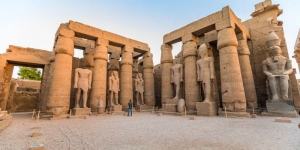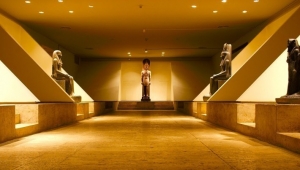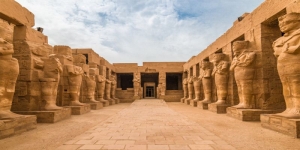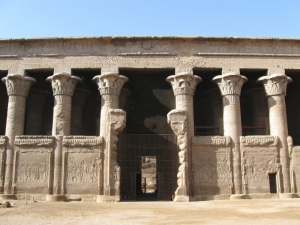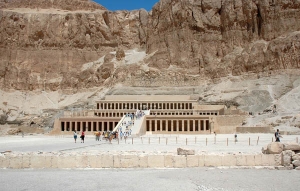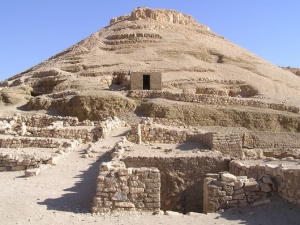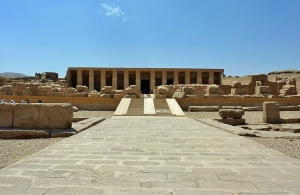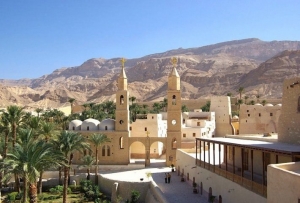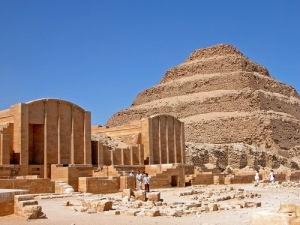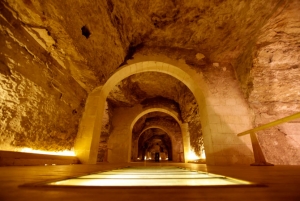+2 0122-345-3028
This email address is being protected from spambots. You need JavaScript enabled to view it.
Super User
Luxor temple
Luxor temple
Many festivals were celebrated in Thebes. The Temple of Luxor was the center of the most important one, the festival of Opet. Built largely by Amenhotep III and Ramesses II, it appears that the temple's purpose was for a suitable setting for the rituals of the festival.
The festival itself was to reconcile the human aspect of the ruler with the divine office.
During the 18th Dynasty the festival lasted eleven days, but had grown to twenty-seven days by the reign of Ramesses III in the 20th Dynasty. The procession of images of the current royal family began at Karnak and ended at the temple of Luxor.
By the late 18th Dynasty the journey was being made by barge, on the Nile River. Each god or goddess was carried in a separate barge that was towed by smaller boats.
Once at the temple, the king and his priests entered the back chambers.
There, the king and his ka (the divine essence of each king, created at his birth) were merged, the king being transformed into a divine being.
The temple of Luxor used to be connected to the Karnak Temple via a long stone processional street called a dromos. The dromos was built by Nectanebo I, and originally was lined on either side by sphinxes. In front of the Luxor temple, the dromos is well preserved, and on the way to the entrance one passes by a Roman chapel of burnt brick dedicated to the god Serapis, which was built during the rule of Hadrian. There is a path that leads to the Nile side of the Temple where one enters the complex.
The Temple of Luxor has a great pylon with carved episodes from the Battle of Kadesh when Ramses defeated the Hittites. There is the one red granite obelisk (a twin one is now at the Place de la Concorde in Paris
Luxor museum
Luxor museum
The Luxor Museum is surprisingly entertaining. Displays of pottery, jewelry, furniture, statues and stelae were created by the Brooklyn Museum of New York. They include a carefully selected assortment of items from the Theban temples and necropolis.
There are a number of exhibits from Tutankhamun, including a cow-goddess head from his tomb on the first floor and his funerary boats on the second floor. However, some of the real attractions include a statue of Tuthmosis III (circa 1436 BC) on the first floor, and 283 sandstone blocks arranged as a wall from the ninth pylon of the Karnak Temple
The Mummification Museum
The museum's features displays of both human and animal mummies. However, there are also displays of tools used in the mummification process, as well as artifacts of items buried along with the mummies for use in the afterlife. Almost anything one ever wanted to know about mummification can be learned here, including the mummification process itself. There is a statue of Anubis, the jackal-god who presided over the dead, at the entrance to the museum.
Karnak Temple
Karnak Temple
The temple of Karnak used to be connected to the Luxor Temple via a long stone processional street called a Dromos. This road was built along a canal that once connected the Nile to the Temple. There was a dock in ancient times, but now all that is left is the quay and the raised dais. To arrive at the entrance one follows the Dromos with its crio-sphinxes. They have the head of a Ram and the body of a lion and are symbolic of the God Amun. Arriving at the temple, there is a statue of Ramesses II with his son between his feet.
The Temple of Karnak is actually three main temples, smaller enclosed temples, and several outer temples. This vast complex was built and enlarged over a thirteen hundred years period. The three main temples of Mut, Monthu and Amun are enclosed by enormous brick walls. The Open Air Museum is located to the north of the first courtyard, across from the Sacred Lake and displays various statues found through out the temple complex. The main complex, The Temple of Amun, is situated in the center of the entire complex. The Temple of Monthu is to the north of the Temple of Amun, while the Temple of Mut is to the south.
The Second Pylon of Karnak was built by Ramesses II. The Ptolemies did some extensive repairing and some new building on the center section.
The Hypostyle Hall is found after passing through the Second Pylon. The hall is considered to be one of the world's greatest architectural masterpieces. Construction began during Ramesses it's reign. He was the king who founded the Nineteenth Dynasty and was king for only one year. The work continued under Seti I (1306 - 1290 BC). Seti I also built the Temple of Abydos and many other temples. The hall was completed by Seti's son, Ramesses II.
The walls, ceilings and columns are painted with the natural earth tones. The light that was allowed in originally kept most of the hall in shadows. The hall ceiling was 82 feet high and was supported by 12 papyrus columns. The columns are made of sandstone and set in two rows of six. Each row is flanked on either side by 7 rows of columns that are 42 feet (12.8m) high. Each row has 9 columns; however the inner rows have 7 columns. The reliefs throughout the hall contain symbolism of Creation. The reliefs in the northern half are from the time period of Seti I, while those in the southern half are done by his son Ramesses II.
The outer walls of the Hypostyle Hall are covered with scenes of battle. It is unsure whether these scenes are based on historical fact or of ritual significance. It is thought that when the battle details are very precise, real events are most likely involved. Seti's battles take place in Lebanon, southern Palestine and Syria. The southern walls of Ramesses II have hieroglyphic texts which actually record details of the Hittite king and Ramesses II signing a peace treaty in the twenty-first year of Ramesses reign. This is the first evidence found for a formal diplomatic agreement and is certainly historical.
Leaving the hypostyle hall through the third pylon you come to a narrow court where there once stood several obelisks. One of the obelisks was erected by Tuthmosis I (1504 - 1492 BC) who was the father of Hatshepsut. This obelisk stands 70 feet (21.3m) tall and weighs about 143 tons. Beyond this obelisk is the only remaining Obelisk of Hatshepsut (1473-1458 BC). It is 97 feet (29.6m) high and weighs approximately 320 tons. Besides the Lateran obelisk in Rome (101 feet high), this is the tallest standing obelisk. The top of the obelisk was visible for 50 miles (80 km). Tuthmosis III (1479-1425 BC), Hatshepsut's successor, built a high wall around her obelisk. This wall hid the lower two-thirds but left the upper towering above. It has been thought that this was an easier and cheaper way of destroying her memory than actually tearing it down and removing it.
The Sixth Pylon, which was built by Tuthmosis III, leads into a Hall of Records in which the king recorded his tributes. Very little remains of this archive beyond two granite pillars. Just beyond these pillars lies the Holy of Holies or sanctuary. Originally it was the oldest part of the temple. The present sanctuary was built by the brother of Alexander the Great, Philip Arrhidaeus (323-316 BC) who was the King of Macedonia. The present sanctuary, built on the site of the earlier sanctuary built by Tuthmosis III, contains blocks from the Tuthmosis sanctuary and still contain Tuthmosis' inscriptions. The sanctuary is built in two sections. Why this was done is not known.
Esna Temple
The temple of Esna
The temple, which lies in a pit below the level of the houses in Isna, is dedicated to the god, Khnum. This the ram god that was worshipped through out this area and who fashioned mankind from mud of the Nile on his potter's wheel.
He was associated with other gods, including Menhyt (his consort), Nebtu (the goddess of the countryside) and Hka (the manifestation of vital energy).
While all that remains of the temple is the Great Hypostyle Hall, surrounding ruins of the ancient complex and city have yet to be excavated due to the modern housing built on the site. The temple sits atop the ruins of earlier temple(s).
Ptolemy VI originally began this building project, but the Temple of Khnum was a later addition built by the Roman emperor Claudius in the 1st century.
The rectangular hall opens to the west.
The roof is still intact, supported by 24 columns decorated with a series of text recording hymns to Khnum and relating the annual sacred festivals of Esna with scenes illustrating the surrounding countryside.
The sacred festivals are the creation of the universe by Neith, the raising of the sky by Khnum, and his victory over the human rebels.
These texts were done between the Graeco-Roman period and the rule of Decius in 250 AD, but were never finished.
There are 16 different palm and plant capitals on the columns, still with some good color.
The west wall of the Temple of Khnum is all that remains of the original Ptolemaic temple and has reliefs of Ptolemy VI and Philometor and Euergetes II.
In the forecourt of the temple are blocks from an early Christian church. Then also is an inscription found on the back of a block from Emperor Decius decreeing that Christians will suffer death if they do not sacrifice to the pagan gods.
El Deir El Bahri
El Deir El Bahari
Lying directly across the Nile from the Great Temple of Amun at Karnak, the rock amphitheater of Deir el-Bahri provides a natural focal point of the west bank terrain and an inviting site for the temples of many rulers.
The natural rock amphitheater, a deep bay in the cliffs, was an important religious and funerary site in the Theban area.
The remains of the temples of Nebhepetre Mentuhotep II, Hatshepsut, and Tutmosis III, as well as private tombs dating to those reigns and through to the Ptolemaic period can be found here.
The most important private tombs at Deir el-Bahri are those of Meketra, which contain many painted wooden funerary models from the Middle Kingdom, and even the first recorded human-headed canopic jar, and the tomb of Senenmut, Hatshepsut’s adviser and tutor to her daughter.
Temple of Nebhepetre Mentuhotep
Nebhepetre Mentuhotep was the first ruler of the 11th Dynasty in the Middle Kingdom. His temple was the first to be built in the great bay of Deir el-Bahri.
It is smaller and not as well-preserved as is the later temple built by Hatshepsut.
The front part of the temple was made of limestone and was dedicated to Montu-Ra, local deity of Thebes before Amun.
The rear of the temple was made of sandstone and was the cult center for the king.
Temple of Tutmosis III
Tutmosis III, the successor to Hatshepsut, built a temple complex here. It was only discovered in 1961.
The complex was built to Amun, as was a chapel to Hathor.
The structure was probably intended to receive the barque of Amun during the Feast of the Valley, and thus would have replaced the temple of Hatshepsut.
After a landslide seriously damaged the temple at the end of the 20th Dynasty, it was apparently abandoned. It then became a quarry, and later, a cemetery for the nearby Coptic monastery.
Temple of Hatshepsut
Hatshepsut was a woman who dared to challenge the tradition of male kingship. She died from undisclosed causes after imposing her will for a time. After her death, her name and memory suffered attempted systematic obliteration.
The temple of Hatshepsut is the best-preserved of the three complexes. Called by the people Djeser-djeseru, "sacred of sacreds", Hatshepsut’s terraced and rock-cut temple is one of the most impressive monuments of the west bank.
The mortuary temple of Queen Hatshepsut is one of the most dramatically situated in the world; it is situated directly against the rock face of Deir el-Bahri’s great rock bay, the temple not only echoed the lines of the surrounding cliffs in its design, but it seems a natural extension of the rock faces.
The queen's architect, Senenmut, designed it and set it at the head of a valley overshadowed by the Peak of the Thebes, the "Lover of Silence," where lived the goddess who presided over the necropolis.
The approach to the temple was along a 121-foot wide, causeway, sphinx-lined, that led from the valley to the pylons. These pylons have now disappeared and ramps led from terrace to terrace.
The porticoes on the lowest terrace are out of proportion and coloring with the rest of the building. They were restored in 1906 to protect the celebrated reliefs depicting the transport of obelisks by barge to Karnak and the miraculous birth of Queen Hatshepsut.
Reliefs on the south side of the middle terrace show the queen's expedition by way of the Red Sea to Punt, the land of incense. Along the front of the upper terrace, a line of large, gently smiling Osirid statues of the queen looked out over the valley. In the shade of the colonnade behind, brightly painted reliefs decorated the walls. Throughout the temple, statues and sphinxes of the queen proliferated. Many of them have been reconstructed, with patience and ingenuity, from the thousands of smashed fragments found by the excavators; some are now in the Cairo Museum, and others the Metropolitan Museum of Art, New york.
Deir El Madina
Deir El Madina
Just southeast of the Valley of the Queens is Deir el-Medina, the ruins of a village that housed the craftsmen and workers who dug and decorated the tombs and other Theban monuments.
It is a very important area to Egyptology, because it has revealed many of the facets of ordinary life in Egypt, and there are some wonderful tombs in its necropolis.
Deir el-Medina dates to the New Kingdom. Deir el-Medina, which in Arabic means "monastery of the city", was called Pa-demi by the workmen, simply, "the town," though it was also called Set Maa, "the place of truth." is one of the most well-preserved ancient settlements in all Egypt.
It lies near Thebes and was a highly skilled community of craftsmen who passed their expertise on from father to son.
The community included the workmen and their wives, children and other dependents, as well as coppersmiths, carpenters, potters, basket-makers, and a part-time physician.
The workers belonged to what we today would call the middle class, having no royal or noble connections, and much of their work was unglamorous.
These workers cut and prepared the tombs in the Valley of the Kings and in the Valley of the Queens, both on the West Bank at Thebes, and were administered directly by the vizier.
They were better educated and better paid than the vast majority of their contemporaries elsewhere in Egypt.
Because of their great skill the workers built their own personal tombs which were always beautifully decorated with paintings on the walls and ceilings. One such tomb is that of Sennedjem where paintings depict husband and wife worshiping the gods of the After-life.
Abydos
Abydos
Abydos, or Abjdu, lies in the eight nome of Upper Egypt, about 300 miles south of Cairo, on the western side of the Nile and about 9.5 miles from the river. It spreads over 5 square miles and contains archaeological remains from all periods of ancient Egyptian history. It was significant in historical times as the main cult center of Osiris, the lord of the netherworld.
Abydos was the burial place for the first kings of a unified Egypt. But it contains remains from earlier, in the Predynastic period.
The Predynasty/Early Dynastic cemetery is located in the low desert. It consists of three parts: predynastic Cemetery U in the north, Cemetery B in the middle with royal tombs from Dynasty 0 and the early 1st Dynasty, and in the south the tomb complexes of six kings and one queen from the 1st dynasty and two kings from the 2nd dynasty. Most of the 1st dynasty tombs show traces of immense fires. Many had also been plundered many times.
North Abydos contains an ancient settlement and also the remains of a large stone temple from the 30th Dynasty, along with a portal structure of Ramesses II, and a fairly recently discovered temple built by Tuthmosis III. Most of the early town lies beneath modern groundwater and the remains of later settlements. Another temple, that of Khentyamentiu which was later identified with Osiris as his temple, dates from the later third millennium BCE.
A residential and industrial section have also been found to the southeast of those excavations, dating to the Old Kingdom and First Intermediate Period. A number of mudbrick houses, consisting of between 7 and 10 small rooms, courtyards and a narrow street have been found. A workshop, the earliest and most complete faience workshop in Egypt, was also uncovered, complete with kilns.
The tombs of the first kings of unified Egypt were deep brick-lined structures topped with mounds of sand, later called mastabas, the Arabic word for bench, since their square or rectangular shapes resembled benches. Later in the 1st Dynasty, one structure was placed underground, supported by a retaining wall, and the second mastaba was placed above ground directly over the first, to protect the lower one.
The Northern cemetery was the principal burial ground for non-royal individuals at Abydos during the Middle Kingdom, and continued to be so used through the Greeco-Roman period.
Monastry of saint antony
monastery of Saint antony
Saint Anthony is often called "the Father of the Monks". He is credited with the founding of Christian monasticism, and many of his ideas are still used to this day by modern monks and nuns. Most of what we know about Anthony comes from the writings of Saint Athanasius the Apostolic, a disciple and close friend of Anthony's.
Anthony was born about AD 251 and was the son of a well-to-do family from middle Egypt. When he was eighteen his parents died, leaving him sole guardian of his younger sister Dious. Six months later, while attending a church, he heard the scripture passage of Jesus and the rich young man, in which Jesus says, "If you would be perfect, go, sell all you have, give to the poor, and follow me (Matt. 19:21)." He took this as a personal invitation from God and sold most of his inherited property, gave much of the money to the poor and the rest to his sister and placed his sister in the care of a community of holy women. He sought guidance from a holy man near Coma in the ways of the Christian ascetic: prayer, fasting, and holiness.
After a time of study, Saint Anthony left on his own and began living in the manner of a mountain hermit, living in a cave and praying for the salvation of the world.
At the age of thirty-five, he moved to Pispir and remained there in solitude for twenty years. During that time, many came to live near him and copy his holy life. He became their spiritual leader, teaching them by word and by example the life of the ascetic. Anthony also taught them to perform manual labor between prayer times as an additional contribution to society.
When the persecutions began again against the Christians in Egypt at the hands of Maximinus Daia in the early 300s, he went to Alexandria and ministered to those in prison. After the persecutions ended, he returned to his life of solitude. He returned to Alexandria once more to support Pope Athanasius against the Arian Heresy in 352, and many came to see the aged holy man as he walked through the city, but he returned to his desert soon after, society no longer having any hold on him. Contrary to popular belief, Anthony founded no formal monastery and his Rule was simply work and prayer. Anthony also designed the first monastic uniform, an all-purpose robe of white linen fastened about the waist with a sturdy leather belt. This has become the basic pattern for monastic garb all over the world and in all times since.
Many came to Saint Anthony for advice, spiritual help, and healing. Saint Anthony died in 356 at the age of one hundred and five and was buried secretly by Macarius and Amatas, two of his most loyal monks.
St. Anthony's Monastery (Deir Mar Antonios), and its neighbor St. Paul's, are the oldest monasteries founded in the Egyptian desert . Hidden deep in the Red Sea Mountains and relying on springs for their water supply, both still observe rituals that have hardly changed in 16 centuries.
St. Anthony's was founded in 356 AD, just after the saints death. Between the 12th and 15th centuries, the monastery flourished but was plundered in 1454 by Bedouin servants. Today it is a self-contained village with gardens, a mill, a bakery and five churches with exceptional wall paintings of holy knights in3 bright colors and the hermit founders of the monastery in subdued colors and icons. There is also a library with over 1,700 handwritten manuscripts, but the Bedouin servants who plundered the monastery used many manuscripts for cooking fuel. At one time, there must have been a much more extensive library. St. Anthony's Cave (magharah), where he lived as a hermit, is a 2 km hike from the monastery and 680 m. above the Red Sea. It offers stunning views of the mountains and the sea, and the chance to see a wide range of bird life.
The Step Pyramid of Djoser
The Step Pyramid of Djoser (Zoser
Across the Great Court of the Pyramid Complex of Djoser (Zoser) (2667 - 2648 BC), the second king of the 3rd Dynasty, stands the Step Pyramid. It is believed to have been created by one man, Imhotep. He has been called Doctor, Sage, Architect, Astronomer and High Priest. During an excavation in 1924-26, a pedestal of a statue of Djoser (Zoser) was found. This complex represents the first major work in stone. That is, unless there are other works that have yet to be found.
On the Pyramid, most of the outer casing is gone. In some places the core masonry has disappeared as well. It is obvious there were different stages of construction. The eastern side gives the best picture, but it can be seen from the northern and southern side as well.
The original structure was an underground burial chamber. This chamber was rare in that it was square; most mastabas were rectangular. The royal tomb is 28m underground with a vertical shaft leading to it. The entrance was sealed with a 3 ton piece of granite. The face of the mastaba was a fine Tura limestone. Apparently it was intended for this to be the finishing touches to the building. It was then enlarged all around with ten feet of additional limestone and then again with an extension on the eastern side. The extension was twenty-five feet of limestone to make the mastaba rectangular. Again, it was enlarged and a two-tiered structure was made. A series of corridors and a tomb chamber was dug. Some of the chambers are lined with blue tiles. Some scholars think this tomb was intended for a member of Djoser's (Zoser's) family, but not for him. The only other site that has similar tiling is in the South Tomb which is located in the Djoser (Zoser) complex as well.
After the third stage was finished, the process to make it a true step pyramid was begun. Over 200,000 tons of stone was used to make the additional two tiers that went above the existing two-tiered structure. An additional two tiers were added above the existing four to make it into the six-tiered pyramid which is there today. A Tura limestone face was added on.
On the northern side of the pyramid, a few blocks of the casing remain. The casing blocks from the Great Pyramid rested on the individual blocks of the core masonry. The casing blocks on the step pyramid were set at an angle to take up the thrust of the successive layers.
The statue of Djoser (Zoser) that was found by excavators, was found in the Tomb Chamber. This statue was damaged but still intact. It is located in the Cairo Museum. The Tomb Chamber has a replica of the statue in this blue-tiled room. It can still be seen through the viewing slit that is at the entrance. The chamber is closed to the public. Scholars believed that the roof of the chamber could give way. The chamber walls have inscriptions that show beyond any doubt that this is indeed a burial chamber. It also contains offering rooms and most of the other features that were often found in both earlier and later tombs.
The Mortuary Temple is just north of the pyramid and is in total ruin. On the southern wall back across the Great Court from the pyramid are carved cobra heads or uraei. The cobra head is an often seen symbol in Egypt. It was once a symbol of the north.
The Southern Tomb is located just outside of the southern wall. Steps lead up the wall to the other tombs and monuments outside the walls. On the left side of the stairs, there is a large hole. At the bottom of the hole, is an entrance that leads to an amazing set of chambers. This Southern Tomb is closed to the public. These chambers are also lined with the blue tiles that are found in the burial chambers in the Step Pyramid. The inscriptions found in these chambers are remarkable. They are perfectly executed and pure in line.
Serapeum
Serapeum
The legendary Serapeum is where the sacred bulls of Apis are buried. This temple was discovered in 1850, and the famous "Squatting Scribe" statue was found.
This statue is considered to be one of the greatest sculptures ever found. Another discovered statue was the statue of the dwarf god, Bes.
Worship of the Apis bull was a late development. The bull was thought to have been an incarnation of Ptah.
The sacred bulls were buried in a single block of granite that weighed between sixty and eighty tons.
All twenty-four sarcophagi had been plundered. Their lids had been praised loose and the contents taken.
There it was found the mummy of a son of Ramesses II, Prince Khaemwese. He was in charge of the restoration of the Pyramid of Unas. He was also governor of Memphis and a high priest of Ptah. He had requested to be buried with the sacred bulls rather than a tomb of his own.
